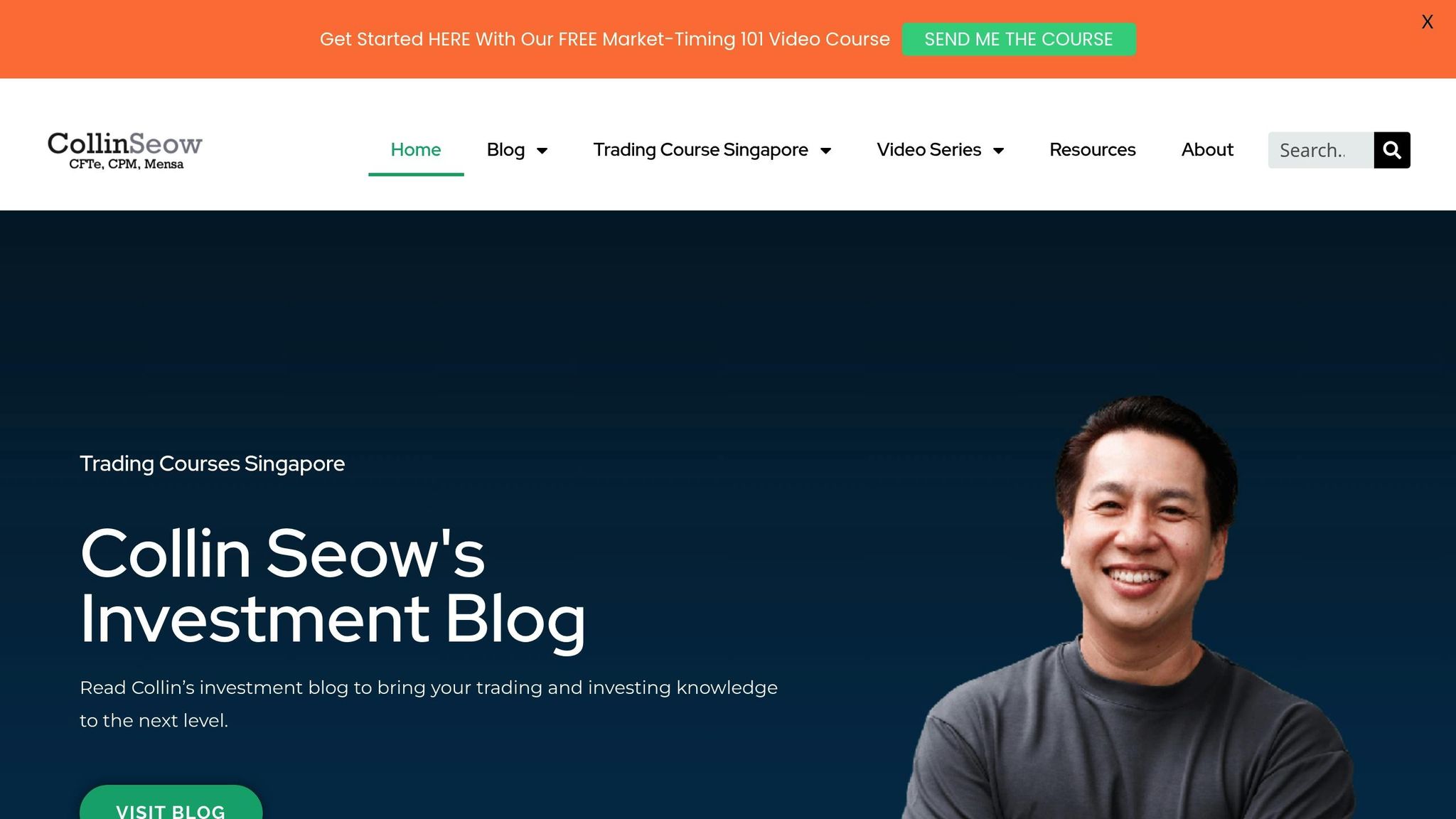Your investment horizon – how long you plan to hold onto your investments – directly impacts your returns and risk. Here’s what you need to know:
- Short-term (1–5 years): Focus on protecting your capital. Safer options like cash equivalents and bonds are ideal, but inflation can erode purchasing power.
- Medium-term (5–10 years): Balance growth and stability. A mix of equities (75%) and bonds (25%) works well, gradually shifting to safer assets as your goal nears.
- Long-term (10+ years): Maximise growth through equities (90%) and leverage compounding. Time helps ride out market dips, but being too cautious can limit returns.
Your time frame determines your risk tolerance, asset choices, and potential returns. Align your investments with your goals to make your money work effectively.
How Time Frames Change Your Returns
Your investment timeline plays a crucial role in determining both your potential returns and the level of risk you’re taking on. By understanding this connection, you can set realistic goals and choose strategies that align with your financial objectives.
Short-term Time Frames: Prioritising Stability
If your investment horizon is less than five years, protecting your capital becomes the top priority. With limited time to recover from market downturns, short-term investments focus on stability over growth.
This approach often involves lower returns, as your funds are likely placed in safer options like cash equivalents or conservative investments. While these choices may not offer significant growth, they are designed to safeguard your money for when you need it. After all, no one wants to risk losing funds they’ll need in the near future.
However, there’s a trade-off. With inflation historically averaging 2% to 3%, keeping money in low-yield investments can mean effectively losing purchasing power – up to 3% annually. So, even in the short term, your strategy should aim to at least match inflation without exposing you to unnecessary risks.
For example, if you’re saving for a car deposit in two years, seeing your savings drop by 20% just before you need them would be disastrous. A conservative approach shields you from such scenarios, even if it means accepting smaller returns. As your timeline extends, though, you can start blending growth with stability.
Medium-term Time Frames: Balancing Growth and Security
Investing for five to 10 years opens the door to a mix of growth and stability. This timeframe allows you to diversify your portfolio, combining higher-growth assets like equities with more stable options such as bonds and cash.
Your allocation can evolve over time. The closer you get to your goal, the more conservative your investments should become. Conversely, the farther away your goal, the more risk you can afford to take. For instance, BlackRock’s capital market assumptions project returns of 8.4% for European equities over five years and 8.2% over 10 years. These figures highlight the potential for meaningful growth while still giving you room to manage short-term risks.
Medium-term strategies are ideal for objectives like saving for a child’s education or building a deposit for property. You have enough time to benefit from market growth, but as your goal approaches, you’ll need to shift focus towards protecting your gains.
Long-term Time Frames: Harnessing Time for Growth
With a long-term horizon, you can fully embrace the benefits of compounding – earning returns on your past returns. This extended timeframe not only helps you recover from market dips but also allows you to maximise growth.
Historical data underscores the resilience of long-term investing. Between 1936 and 2024, the U.S. stock market never experienced negative returns over any 20-year rolling period. Similarly, since 1972, the S&P 500 has delivered positive returns on all rolling timeframes exceeding 12 years. Even with average intra-year declines of nearly 15%, the S&P 500 has averaged annual returns of about 10% over the past 20 years.
Staying invested is key to long-term success. Missing just a handful of the best-performing days can severely impact your returns. An investor who stayed invested for 20 years would have earned 58% more than one who missed the five best days. Missing the 25 best days would have wiped out three-quarters of the potential gains.
“The first rule of compounding: Never interrupt it unnecessarily”
Interestingly, one of the biggest risks for long-term investors isn’t market volatility – it’s being too cautious. When you have decades ahead, playing it too safe can cost you more than riding out market fluctuations ever would.
Asset Allocation for Different Time Frames
Choosing the right asset allocation for your investment time frame is a key step in managing risk and achieving your financial goals. Your portfolio should reflect the level of risk you’re willing to take based on how long you plan to invest.
Short-term Asset Allocation
If your investment goals are within one to three years, the focus should be on protecting your capital rather than chasing growth. Liquidity and low risk are the priorities here, ensuring that funds can be accessed quickly without significant losses.
Options like money market funds offer stable returns with minimal risk, making them a reliable choice. High-yield savings accounts and robo-advisor cash management accounts provide additional security for short-term needs. For slightly longer short-term goals, government bonds such as Singapore Government Securities (SGS) bonds are attractive due to their predictable returns and near-zero risk for local investors.
A suggested allocation for short-term goals could be:
- 70% in cash equivalents or money market funds
- 20% in short-term government bonds
- 10% in high-yield savings accounts
This conservative mix ensures that your funds remain accessible and secure when you need them.
As your time frame extends beyond three years, you can start incorporating assets with higher growth potential into your portfolio.
Medium-term Asset Allocation
For goals spanning four to 10 years, you’ll want a balance between growth and stability. This time frame allows for some risk-taking while still maintaining a level of security. Many experts, including those cited by CNBC, suggest a portfolio allocation of around 75% equities and 25% bonds for this period.
Exchange-traded funds (ETFs) are a strong option here, offering flexibility with intraday trading. Unit trusts also provide professional management and diversification across various asset classes. As your target date approaches, gradually adjust your allocation by moving from growth assets to safer investments to protect your gains.
Long-term Asset Allocation
For investment horizons exceeding 10 years, the focus shifts to maximising growth. With time on your side, you can afford to ride out market fluctuations and benefit from the compounding effect of long-term returns. Many financial experts recommend keeping at least 90% of your portfolio in equities for long-term goals, with the remaining 10% in bonds or cash to facilitate periodic rebalancing.
In a long-term portfolio, diversification is key. Spread your investments across domestic and international stocks, various sectors, and companies of different sizes. Dollar-cost averaging is another useful strategy, helping you navigate market volatility and stick to a disciplined investment approach.
However, avoid over-diversification, as it can dilute your returns. Focus on meaningful diversification by selecting investments that truly add value to your portfolio. Regular portfolio reviews and rebalancing are essential to ensure your allocation aligns with your evolving financial goals.
| Time Frame | Primary Focus | Typical Allocation | Key Considerations |
|---|---|---|---|
| Short-term (1–3 years) | Capital preservation | 70% cash equivalents/money market funds, 20% government bonds, 10% high-yield savings accounts | Prioritise liquidity and low risk |
| Medium-term (4–10 years) | Balanced growth | 75% equities, 25% bonds | Gradually shift to safer assets as the target date nears |
| Long-term (10+ years) | Maximum growth | 90% equities, 10% bonds or cash | Use compounding, diversify wisely, and rebalance regularly |
Master Systematic Trading with Collin Seow
Learn proven trading strategies, improve your market timing, and achieve financial success with our expert-led courses and resources.
Risks for Each Investment Time Frame
Investing is never a one-size-fits-all approach. The risks you face depend heavily on your investment time frame, and each horizon comes with its own challenges that require thoughtful strategies to navigate.
Short-term Investment Risks
Short-term investments bring a higher level of uncertainty due to their susceptibility to market volatility and the limited time available to recover from downturns. For those looking at horizons of one to three years, even small market fluctuations can have a big impact, especially if you need to access your funds during a downturn. Timing risk is another concern – if the market dips just as you need liquidity, you may be forced to sell at a loss.
Freddy Lim, a trading expert, sums it up well:
“In the short term, riskier investments fluctuate more and, therefore, can give much higher returns or much lower (negative!) returns than lower-risk investments: a short-term investment in a high-risk asset may end up in a significant loss at the time you were planning to liquidate the investment to pay for the goal you were targeting.”
To reduce these risks, it’s wise to adjust your portfolio as your need for funds approaches. Keep a portion of your investments in highly liquid assets to ensure cash availability when needed. Emergency funds should also include a cash component for added security.
While short-term strategies focus on liquidity, long-term investments face their own distinct set of challenges.
Long-term Investment Risks
Long-term investments tend to be less volatile, but that doesn’t mean they’re risk-free. Inflation is a significant concern. For instance, Singapore’s inflation rate stood at 1.6% in December 2024, with the Monetary Authority of Singapore predicting headline inflation to range between 1.5% and 2.5% in 2025. With essential expenses like housing, food, and transport making up large portions of the Consumer Price Index (25%, 22%, and 16% respectively), prolonged inflation can erode purchasing power if your investments don’t grow fast enough to keep up.
Another issue is sequence-of-returns risk, where early losses in a portfolio can disproportionately affect long-term wealth. To counteract these risks, diversifying into real assets like property and precious metals can be beneficial. For example, Singapore REITs offer an average yield of 6.9%, which can help outpace inflation. Additionally, multi-currency deposits provide a way to hedge against currency fluctuations, leveraging Singapore’s reputation as a global banking hub.
Investment Factors in Singapore
When investing in Singapore, it’s crucial to consider the unique local factors that influence outcomes. Government policies and regulations play a significant role, particularly in sectors like banking, telecommunications, and energy. As of April 2024, state-owned enterprises (SOEs) made up 26.1% of the Singapore Exchange’s market capitalisation, highlighting the influence of government-linked entities.
Foreign investment restrictions in sectors critical to national security also limit diversification opportunities. Minister Gan Kim Yong explains:
“Investors in a critical entity will normally have some form of influence or control of the entity’s decisions or its operations. Investors may then exploit their ownership and control over these entities to disrupt the delivery of essential goods and services, or access and use sensitive information, to threaten our national security.”
On the other hand, local investment tools like the Central Provident Fund (CPF) offer unique advantages. For example, transferring excess funds from the Ordinary Account to the CPF Special Account, which guarantees a 4% annual return, can optimise returns while ensuring capital protection.
Singapore’s Green Plan 2030 also introduces both opportunities and challenges. Companies aligned with sustainability goals stand to benefit, while traditional industries may face increased pressure. Labour policies favouring local workers – who make up 61% of the workforce – add another layer of complexity.
As a global trade hub, Singapore’s economy is highly sensitive to international trends. With a trade-to-GDP ratio of 320% as of 2020 and U.S. foreign direct investment reaching US$309 billion in 2022, global economic shifts can significantly impact local investments. Minister Gan Kim Yong emphasises this point:
“It is critical for Singapore to remain open and connected to the world, and as such we must continually strengthen our position as a trusted hub for businesses to invest with confidence.”
Systematic Methods to Match Time Frames with Goals
Building a disciplined investment strategy starts with aligning your financial goals to specific time horizons. A structured approach helps you make informed decisions, whether you’re planning for short-term needs or aiming to grow wealth over the long haul.
Why Systematic Trading Works
Systematic trading offers a structured way to make investment decisions by focusing on three key questions: What to buy? When to buy? How much to buy? Instead of relying on instincts or reacting to market buzz, this method uses predefined rules to guide your actions. This is especially useful when balancing investments for immediate liquidity needs versus long-term financial growth.
Did you know that 90% of traders lose money due to impulsive decisions? Systematic trading helps eliminate emotional biases. By sticking to rules for entry and exit points, you can avoid panic during market dips or overconfidence during rallies.
Another critical element is strategic position sizing – deciding how much to invest in each trade based on your risk tolerance and the trade’s risk-reward potential. For example, a five-year investment horizon might lean towards growth stocks, while a shorter two-year horizon could favour more conservative sectors.
Predetermined rules for entry, exit, and position sizing not only reduce uncertainty but also improve risk management. This approach is particularly relevant in Singapore, where market shifts – often influenced by government-linked companies or regulatory updates – can significantly impact investment outcomes.
With these benefits in mind, let’s dive into some practical resources for adopting systematic trading strategies.
Tools from Collin Seow Trading Academy

The Collin Seow Trading Academy offers a range of resources to help traders develop systematic strategies tailored to their investment time frames. Their approach combines technical analysis with market trends, making it easier to pinpoint ideal entry points – whether you’re investing for six months or six years.
Their Systematic Trader Program revolves around the concept of Systematic Trend Trading, which relies on strict rules rather than gut-based decisions. The program has earned stellar feedback, boasting a 4.9/5 rating on SeedlyReviews from over 2,000 users. Many participants, including beginners, find it practical and easy to follow.
The academy also provides access to the TradersGPS software, a tool designed to simplify systematic trading. As Conan Lai shared in May 2025:
“The TraderGPS is easy to use and gives me confidence to trade in the stock market”.
Real-world success stories highlight the effectiveness of these strategies. For instance, one student, Thomas, achieved over 100% returns in just eight months using systematic trading. Another trader, Chong Yoon Fatt, entered a stock at HK$14.57 on 26 November and watched it climb to HK$16.24 within six days – a gain of 11.5%.
For those looking to get started, the academy also offers free resources like the Market Timing 101 E-Course and the Systematic Trading Profits programme, which introduces a 3-Phase Growth System for mastering stock trading. These tools can help you customise strategies to match your time frames and risk preferences.
By using systematic trading, you can better align your investments with your goals. However, as your circumstances and time horizons change, it’s important to adjust your strategies accordingly.
Evolving Strategies for Changing Time Frames
Investment plans aren’t set in stone – they shift as your goals and life situations evolve. A systematic approach requires regular reviews to ensure your portfolio stays aligned with your updated time horizons.
Quantitative analysis plays a key role here, allowing traders to tweak strategies as market conditions change. For example, as new data becomes available, you can refine your models to keep your approach effective – an important consideration in Singapore’s fast-moving market.
When your time frame shortens, your strategy should adjust automatically. This might mean fine-tuning rules, changing parameters, or even creating new strategies. The key is to rely on preset guidelines rather than making impulsive decisions.
Risk management and position sizing also need to evolve. A strategy designed for a 15-year plan may not work when you’re just three years away from needing those funds. Systematic traders continuously monitor their performance, experimenting with new approaches to meet their changing needs.
The real strength of systematic trading lies in its ability to adapt without requiring a complete overhaul. By making calculated adjustments based on clear criteria, you can avoid emotional pitfalls and keep your investments on track to meet your long-term goals.
Conclusion: Key Points on Investment Time Frames and Returns
Your investment horizon plays a big role in shaping your returns. Generally, the longer you stay invested, the higher your potential gains – provided you manage the risks effectively.
It’s important to align your investment horizon with your financial goals. If you’re saving for something in the near future, like a holiday or a major purchase, a shorter time frame is better. On the other hand, long-term goals like retirement require a much longer horizon. Your risk tolerance also matters – longer horizons can handle more volatility, while shorter ones call for more stable options.
Choosing the right assets for your timeline is key. Long-term goals often benefit from equities and mutual funds, while bonds or fixed-income instruments are better suited for short-term needs. To avoid emotional decision-making, consider systematic trading strategies that rely on predefined rules. These can help you stay consistent, no matter the time frame.
Market conditions, like bull runs or downturns, can also impact your decisions. Staying aware of these shifts is crucial.
Don’t underestimate the power of compounding. Over time, reinvested returns can significantly boost your overall gains, making a strong case for staying invested over the long haul.
Regularly revisiting your investment strategy is just as important. Life circumstances and market conditions change, and your approach should evolve with them. This might mean adjusting your asset allocation, rebalancing your portfolio, or tweaking your systematic trading rules to stay on track.
Ultimately, successful investing comes down to aligning your time horizon with a disciplined strategy. Techniques like dollar-cost averaging, diversification, and systematic risk management can keep your investments steady even when the markets fluctuate. Whether you’re saving for a short-term goal or planning decades ahead, matching your time frame with the right strategies and risk levels can help you work towards financial success.
FAQs
How do I balance growth and stability in a medium-term investment portfolio?
To strike a balance between growth and stability in a medium-term investment portfolio, start with diversification. A good mix could include equities for growth potential and bonds or cash equivalents to add stability. The exact combination depends on your financial goals and how much risk you’re comfortable taking.
As time goes on, it’s wise to revisit your asset allocation. For instance, as you move closer to the end of the medium-term horizon, you might want to gradually shift away from riskier investments to protect your returns. In Singapore, keep an eye on local currency trends and market conditions, as these can impact your strategy. By staying adaptable and spreading your investments wisely, you can aim for returns while keeping risks under control.
What are the risks of being overly cautious with long-term investments?
Being too cautious with a long-term investment approach can hold back your financial growth. If you keep too much of your money in cash or shy away from market exposure, you could miss out on opportunities for better returns. Over time, this could make it harder to grow your wealth effectively.
An overly conservative strategy also means you might not take full advantage of compounding gains, which play a key role in building wealth over the years. In times of inflation, low returns may not keep pace with rising prices, eating into your purchasing power and diminishing the real value of your savings. Finding the right balance between caution and risk is critical to reaching your financial goals.
How does inflation affect short-term investment returns, and what can you do to reduce its impact?
Inflation has a sneaky way of eating into the real value of your investment returns. When inflation outpaces the nominal gains on your short-term investments, it effectively reduces your purchasing power. This becomes a real problem if your investments can’t keep up, resulting in negative real returns.
To help shield your wealth from inflation’s impact, you can take a few practical steps. Start by diversifying your portfolio – spread your investments across different asset classes to balance risk and returns. Consider putting money into inflation-protected securities, such as Treasury Inflation-Protected Securities (TIPS), which are designed to keep pace with rising prices. Lastly, avoid holding too much cash or relying heavily on fixed-income investments, as these tend to be more vulnerable to inflation. These strategies can help you preserve your wealth and maintain its value over time.












